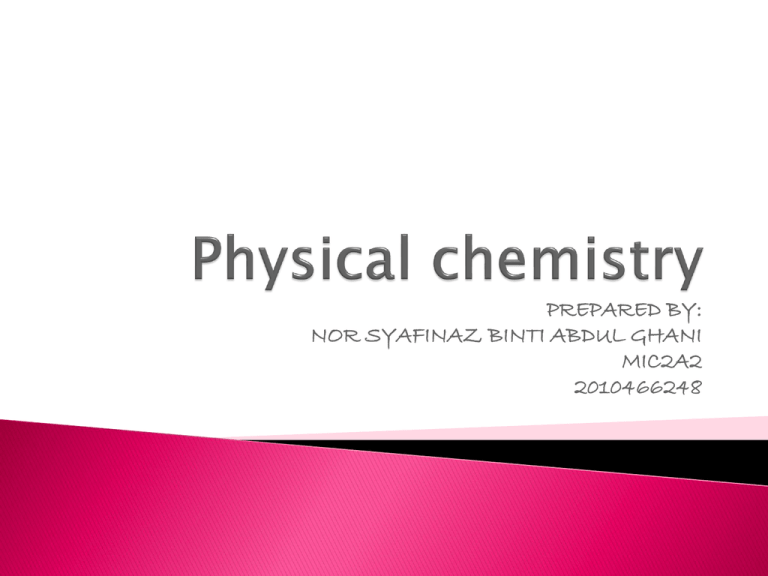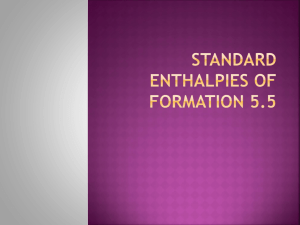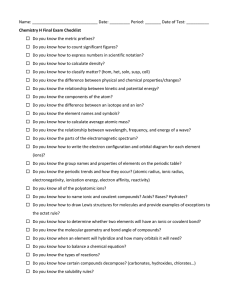Chapter 1 - WordPress.com
advertisement

PREPARED BY: NOR SYAFINAZ BINTI ABDUL GHANI MIC2A2 2010466248 THERMOCHEMISTRY Thermal energy is the energy associated with the random motion of atoms and molecules. Heat is the transfer of thermal energy between two bodies that are different temperature. Temperature is a measure of thermal energy. Enthalpy of a system is the heat content of the system or the sum of the internal energy and the product of its pressure & volume. Also known as heat content. Enthalpy (H) is used to quantify the heat flow into and out of a system in a process that occurs at constant pressure ∆H˚=∑ H˚ᶠ(products)-∑H˚ᶠ(reactants) ∆H : heat given off or absorbed during a reaction at constant pressure. exothermi c Internal energy of reactant is greater than the product endothermic Internal energy of product is greater than the reactant Heat released to the surrounding Heat is absorbed from the surrounding ∆H is negative ∆H is positive ∆H<0 ∆H>0 2H2(g) + O2(g) energy heat 2H2O(l) 2Hg (l) + O2(g) Energy heat 2HgO(s) The enthalpy of combustion •Energy released as heat when a compound undergoes complete combustion with oxygen under stated condition of temperature & pressure. The enthalpy of neutralisation •Heat released when one mole water is formed when an acid reacts with a base under stated condition or during the neutralisation of strong acid by an alkali. •The value is always negative The enthalpy of solution •The heat change when one mole of substance or a certain amount of solute dissolve in a certain amount of solvent. The enthalpy of formation •The heat change when one mole of a compound is formed from its element s at stated temperature and pressure. The enthalpy of reaction •The enthalpy change in reaction when both reactantas and products are at their standard states at 298 K. Calorimetry •Measurement of heat flow. Calorimeter •Apparatus that measures heat flow. Molar heat capacity •Heat capacity of 1 mol of a substance. Heat capacity •The amount of energy required to raise the temperature of an object. Specific heat capacity •Heat capacity of 1g of a substance. For any chemical change made in several steps, the net ∆H is equal to the sum of the ∆H values of the separate steps Balance the equation(s). complete balancing – all levels must have same atoms Add axes and ∆H values. Sketch a rough draft based on ∆H values. Draw the overall chemical reaction as an enthalpy diagram. Check arrows. Draw a reaction representing the intermediate step. Enthalpy cycle used to calculate lattice enthalpy of an ionic compound Two different routes to form an ionic compound. The enthalpy change when one mole of an ionic solid is formed from its gaseous ions. The values are always negative because of formation of ionic bond. CHEMICAL KINETICS The change in the concentration of a reactant or a product with time (M/s) A B reactant(-) product(+) rate of appearance = positive rate of dissapearance = negative Expresses the relationship of the rate of reaction to the rate constant and the concentrations of reactants raised to some powers. aA+bB→ cC+dD Rate = k [A]x [B]y Order of reaction xth order in A yth order in B (x+y)th is the overall order ORDER RATE LAW CONCENTRATI ON- TIME EQUATION HALF-LIFE 0 Rate=k [A]= [A]- kt .t1/2=[A]/2k 1 Rate=k[A] Ln[A]= ln[A]-kt t1/2= ln2/k 2 rate=k[A]^2 1/[A]=1/[A] +kt t1/2= 1/k[A] Concentration of reactants – concentration of reactants increase, so does the likehood that reactant molecules will collide. Temperature – at high temperature,reactants molecules have more kinetic energy,move faster and collide more often. Catalyst – speed rxn by changing mechanism. Activation energy – minimum amount of energy required for reaction. k= (-Ea/RT) A.e Ea = activation energy (J/mol) R = gas constant (8.314 J/K.mol) T = absolute temperature A = frequency factor At two temperature, T1 and T2 Ln k1/k2=Ea/R(1/T2-1/T1) The overall progress of a chemical reaction represented by a series of elementary steps. The sequence of elementary steps lead to product formation is the reaction mechanism. Molecularity Unimolecular Elementary reaction A product Rate law Rate = k[A] Bimolecular A+A product Rate = k[A]2 Bimolecular A+B product Rate = k[A][B] Termolecular A + A +A product Rate = k[A]3 Termolecular A+A+B product Rate = k[A]2[B] Termolecular A+B+C product Rate = k[A][B][C] CHEMICAL EQUILIBRIUM Homogenous equilibrium Heterogenous equilibrium •Reacting species are the same phase •i.e: N2O2(g) 2NO2(g) •K’c = [ NO2 ]2 / [ N2O2 ] •Reactants and product are in different phases •i.e: CaCo3 (s) CaO (s) + CO2 (g) •K’c = [CaO] /[CaCo3] •The concentration of solid and pure liquid are not included in the expression for the equilibrium contant. K p = Kc ∆n (RT) R = room pressure = 0.0821 ∆n = moles of gaseous productsmoles og gaseous reactant If an external stress is applied to a system at equilibrium,the system adjusts in such a way that the stress is partially offset as the system reaches a new equilibrium position change Shift equilibrium Change equilibrium constant Concentration yes no Pressure Yes no Volume Yes no Temperature Yes yes catalyst No no IONIC EQUILIBRIUM ᾱ = [H3O] / [acid] ᾱ = [H3O] / [acid] x 100 1.For strong acid pH=-log [H] 2.For weak acid [H]=√KaC [OH]=√KbC 3.pH of Buffer pH= pKa-log[acid/salt] pOH=pKa-log[base/salt] pKa= -logKa 4. Kw = [H][OH] = Ka x Kb = 1 x 10-4 PHASE EQUILIBRIUM A homogeneous system Separated from other parts of system by a dinstinct boundary 3 phase of state solid liquid gaseous No boundary between subtances – hemogenous i.e: g-g system : oxygen and nitrogen l-l system : water and ethanol s-s system : gemstone Two substance with a boundary separating them i.e: l-l : water and oil l-g : water and water vapour s-g : ice and water vapour s-l : ice and water 3 substance with boundaries separating each other i.e: s-l-g : ice, water and water vapour system The least number of independently variable constituents which must be specified so that composition of each and every phase is described. The smallest number of independent variables of components (temperature, pressure, concentration) which must be specified to define completely the remaining variables of the system F=C–P+2 More components, more degree of freedom More phases involved, less degree of freedom Water and carbon dioxide pressure, atm solid liquid 0.006 gas 0.01 temperature,(0c) pressure, atm liquid solid 5.1 gas -57 temperature, (0c) Two completely immisible solids (l-s) Eutectic mixture – a mixture of 2 or more subtance with melting point lower than any other mixture of the same subtance Eutectic system – a mixture of chemical compounds or elements that has a single chemical composition that solidifies at a lower temperature than any other temperature Deviation from raoult’s law Negative deviation Positive deviation •Vapour-composition diagram of solution have minimum point •Vapour-composition diagram of solution have maximum point •Boiling-composition diagram has maximum point •Boiling-composition diagram has minimum point Partition coefficient= the ratio between the concentration of the solute in the two solvents is, experimentally constant. Kc= [solute in upper layer]/[solute in the lower layer] Kc= X/volume of ether mass of substance-X/volume of water







